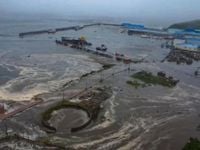Residents of Russia’s Kamchatka Peninsula and the surrounding Pacific region are once again grappling with the unsettling rumble of the earth beneath their feet. Less than two months after a colossal 8.8 magnitude earthquake rattled the area, a powerful 7.8 magnitude aftershock struck off Kamchatka’s coast early on September 19, 2025, according to the U.S. Geological Survey (USGS). The Alaska Earthquake Center and Russia’s Emergencies Ministry both confirmed the event, with the USGS identifying it as the largest aftershock since July’s historic quake.
For those living in one of the world’s most seismically active zones, this latest tremor was a stark reminder that the earth’s restlessness is far from over. The Kamchatka Peninsula, jutting into the Pacific and Bering Sea, sits atop the volatile Kuril-Kamchatka plate boundary. Here, the Pacific plate is steadily subducting beneath the North American plate, making the region a hotspot for major earthquakes and tsunamis. As the Alaska Earthquake Center’s seismologist Heather McFarlin explained, “When you have a large earthquake like this, you’re going to have lots of aftershocks because stress has been building up over time and it’s not all going to be released in one big earthquake.”
Thursday’s aftershock (which occurred early Friday local time in Kamchatka) registered a magnitude of 7.8, though Russia’s Emergencies Ministry reported it as 7.2. The quake was caused by shallow reverse faulting at a depth of just 10 kilometers (about 6.2 miles), according to the USGS, and was followed by a series of smaller aftershocks, some as strong as magnitude 5.8. The force of the quake was enough to trigger tsunami warnings and advisories around the Pacific, including for the Aleutian Islands and parts of Alaska, but these were cancelled within hours as the threat subsided.
Despite the magnitude, the impact on the ground was mercifully limited. Kamchatka regional Governor Vladimir Solodov reassured residents, stating, “This morning is once again testing the resilience of Kamchatka residents. Immediately after the earthquake, we began a rapid inspection of social institutions and residential buildings.” No damage was reported in the sparsely populated region, though emergency services were placed on high alert. Videos posted to social media captured the moment of the quake—light fixtures swinging, furniture vibrating, and car alarms blaring in the streets—but the destruction that so often accompanies such powerful tremors did not materialize this time.
The tsunami threat, too, was relatively minor. The Alaska Earthquake Center reported that the aftershock produced a small tsunami, with waves measured between 30 and 62 centimeters (1 to 2 feet) along the Kamchatka coast. The July 29 earthquake, in contrast, had triggered a tsunami that reached the Aleutian Islands and even flooded a seaport town, prompting warnings across the entire Pacific. Yet, even then, the waves failed to reach mainland Alaska, a testament to the complex interplay of local geology and ocean dynamics that can sometimes blunt the force of these disasters.
For the scientific community, these events are a vivid illustration of the unpredictability and power of plate tectonics. The Kuril-Kamchatka boundary is notorious for its seismic volatility. As Scientific American reported, the July 29 quake was among the ten strongest ever recorded. The 7.8 aftershock, while significant, released more than 30 times less energy than its predecessor, thanks to the logarithmic scale used to measure earthquakes. “You’re going to have other parts of the fault that have to have their stress released, and so, yeah, you’re going to get lots of earthquakes in that area along that fault that are going to happen over the next several years,” McFarlin added, underscoring the likelihood of continued seismic activity in the region.
Aftershocks are not just a footnote to a major quake—they can be dangerous in their own right. In some cases, aftershocks have even surpassed the original event in magnitude, prompting seismologists to retroactively reclassify the initial tremor as a “foreshock.” The July 29 earthquake itself was preceded by a series of foreshocks, including one measuring about 7.4, which many at the time believed to be the main event. “We thought that would be the mainshock cause it had all of its own aftershock sequences,” McFarlin recalled. “And then the 8.8 happened.”
As for the tsunami threat, officials moved quickly to reassure the public as new data rolled in. The US National Weather Service and the Pacific Tsunami Warning Center issued advisories for Alaska and Hawaii, but by late afternoon on September 18, the all-clear was given for Hawaii. No giant waves were observed crossing the Pacific, and the small tsunami that did reach the Kamchatka coast posed no danger to residents. The Kuril Islands to the south also received a tsunami warning, but again, no significant impact was reported.
Kamchatka’s seismically active status is nothing new. At least two earthquakes with magnitudes greater than 7.0 have shaken the region in the past week alone, according to Al Jazeera. The peninsula’s rugged, volcanic landscape is a direct result of the tectonic forces at play beneath it. For the people who call this remote corner of Russia home, preparedness is a way of life. Emergency drills, building inspections, and rapid response protocols are standard operating procedure whenever the earth begins to shake.
Yet, even with all this vigilance, the unpredictability of earthquakes remains daunting. While McFarlin and her colleagues at the Alaska Earthquake Center do not expect aftershocks in Kamchatka to trigger quakes elsewhere in the world, they warn that aftershocks could continue for years. Some may even exceed the magnitude of the July 29 event, in which case the seismic narrative would have to be rewritten once again.
For now, the people of Kamchatka, Alaska, and the wider Pacific can breathe a little easier. The latest aftershock, though powerful, has left the region largely unscathed. But as history and geology both remind us, the story of the Kuril-Kamchatka fault is far from over—and the next chapter could be just a tremor away.

